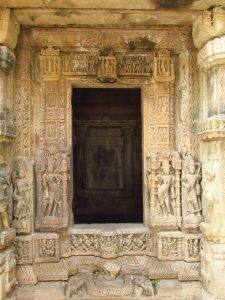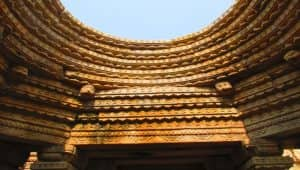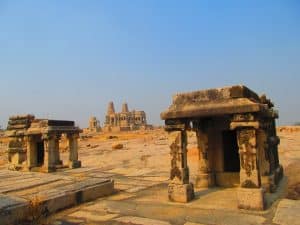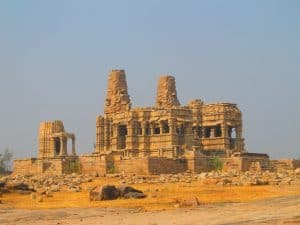It was in 1986 that Khajuraho became the first site in Madhya Pradesh to get UNESCO World Heritage status. In the period of nearly four decades since then, two more sites – Sanchi (in 1989) and Bhimbetka (2003) – have attained that status, with others such as Mandu and Orchha on the tentative list. However, while each of these world heritage sites has drawn visitors in thousands, the opportunity that has perhaps been missed is to extend the imprint of these individual sites to encompass other, stunning examples of heritage in their vicinity. Places such as Udayagiri, close to Sanchi, remain obscure. As does the fact that Bhimbetka itself is part of a much larger cluster of rock art sites, touching Bhopal. Or a site like Vyas Bhadora, which houses a group of majestic temples whose antiquity predates that of Khajuraho itself. It is this last site that we will dwell on, given both its similarities as well as contrasts from Khajuraho, which lies a mere two-hour drive away. [caption id=“attachment_13586272” align=“alignnone” width=“370”] Carved doorway of a Shiva Temples[/caption] While the physical distance between Khajuraho and Vyas Bhadora can be bridged in two hours, the gap in terms of awareness, tourist infrastructure and consequent development may take more than a generation to cover. Located in Chhatarpur, the same district as the world-famous temple town, Vyas Bhadora is off the radar of any visitors to the region. Located north of the temple town, Vyas Bhadora lies on the road connecting the towns of Laundi and Chandla – two names that are dots on the map for a visitor and whose inhabitants are unconcerned about the heritage in their midst. A surfaced road, built under the aegis of the Gram Sadak Yojana, brings a visitor to the place. [caption id=“attachment_13586262” align=“alignnone” width=“452”]
Carved doorway of a Shiva Temples[/caption] While the physical distance between Khajuraho and Vyas Bhadora can be bridged in two hours, the gap in terms of awareness, tourist infrastructure and consequent development may take more than a generation to cover. Located in Chhatarpur, the same district as the world-famous temple town, Vyas Bhadora is off the radar of any visitors to the region. Located north of the temple town, Vyas Bhadora lies on the road connecting the towns of Laundi and Chandla – two names that are dots on the map for a visitor and whose inhabitants are unconcerned about the heritage in their midst. A surfaced road, built under the aegis of the Gram Sadak Yojana, brings a visitor to the place. [caption id=“attachment_13586262” align=“alignnone” width=“452”] Spectacular patterns on the ceiling of a Vyas Bhadora temple[/caption] The place is clean, though sans any hint of prosperity. Some houses are made of mud. Locals are ever curious about any visitors to their simple hamlet, possibly a little surprised that anyone other than government functionaries would care to visit. As a visitor keeps walking, the houses and the stares of their denizens are left behind and something else comes into view. It is a sight that leaves the intrepid traveller who comes this far astonished. At the edge of this featureless village lies a stunningly elegant group of ancient temples showcasing varied designs and styles. Almost golden in colour, the structures stand out against the lush green background, almost aglow. The highlight is a set of twin Shiva temples, two fragile looking structures that arrest one’s attention with their tall shikharas. Standing on a large stone platform, they are linked to each other by a small passage, making them seem like conjoined twins. On one side of the platform is a smaller, subsidiary shrine. All around are broken fragments of temples that have been lost. Compared to Khajuraho, the Vyas Bhadora temples are rather plain on the outside with only geometric patterns used. The artisans seem to have reserved their creativity for the inside, with elaborate mandapas, sculpted ceilings and richly carved doorways to the inner sanctum showcasing divine beings. Close to the main temples are more shrines, described by archaeologists as being dedicated to Yoginis. Even less embellished than the Shiva temples, they are of a design and style very distinct from the twin shrines. [caption id=“attachment_13586282” align=“alignnone” width=“456”]
Spectacular patterns on the ceiling of a Vyas Bhadora temple[/caption] The place is clean, though sans any hint of prosperity. Some houses are made of mud. Locals are ever curious about any visitors to their simple hamlet, possibly a little surprised that anyone other than government functionaries would care to visit. As a visitor keeps walking, the houses and the stares of their denizens are left behind and something else comes into view. It is a sight that leaves the intrepid traveller who comes this far astonished. At the edge of this featureless village lies a stunningly elegant group of ancient temples showcasing varied designs and styles. Almost golden in colour, the structures stand out against the lush green background, almost aglow. The highlight is a set of twin Shiva temples, two fragile looking structures that arrest one’s attention with their tall shikharas. Standing on a large stone platform, they are linked to each other by a small passage, making them seem like conjoined twins. On one side of the platform is a smaller, subsidiary shrine. All around are broken fragments of temples that have been lost. Compared to Khajuraho, the Vyas Bhadora temples are rather plain on the outside with only geometric patterns used. The artisans seem to have reserved their creativity for the inside, with elaborate mandapas, sculpted ceilings and richly carved doorways to the inner sanctum showcasing divine beings. Close to the main temples are more shrines, described by archaeologists as being dedicated to Yoginis. Even less embellished than the Shiva temples, they are of a design and style very distinct from the twin shrines. [caption id=“attachment_13586282” align=“alignnone” width=“456”] Smaller shrines with the Shiva Temples in the background[/caption] As per historians, the Vyas Bhadora temples were built by the Chandella dynasty, which also built the temples at Khajuraho. At a short distance from the Yogini temples is a huge stone embankment, the purpose of which seems to have been to create a reservoir of water in a low-lying area. Such water tanks were another signature project of the Chandellas, who dominated the region between the 9th and 12th centuries CE. Vyas Bhadora’s temple architecture is unique in many respects. It has temples that follow two distinct designs. Further, the site has thrown up evidence that these temples predate the ones at Khajuraho, thus indicating a possible learning curve for the artisans. The more basic-looking Yogini shrines may have come first followed by the twin Shiva temples, all made of granite – a stone which does not allow much embellishment. Possibly because of this learning, the bulk of Khajuraho’s temples were made of sandstone. The site brings alive the phased development of temple architecture in the region. It was only in 1990 that the temples at Vyas Bhadora came under the protection of the state government, with the painstaking restoration that came later helping conserve the site for posterity. [caption id=“attachment_13586292” align=“alignnone” width=“472”]
Smaller shrines with the Shiva Temples in the background[/caption] As per historians, the Vyas Bhadora temples were built by the Chandella dynasty, which also built the temples at Khajuraho. At a short distance from the Yogini temples is a huge stone embankment, the purpose of which seems to have been to create a reservoir of water in a low-lying area. Such water tanks were another signature project of the Chandellas, who dominated the region between the 9th and 12th centuries CE. Vyas Bhadora’s temple architecture is unique in many respects. It has temples that follow two distinct designs. Further, the site has thrown up evidence that these temples predate the ones at Khajuraho, thus indicating a possible learning curve for the artisans. The more basic-looking Yogini shrines may have come first followed by the twin Shiva temples, all made of granite – a stone which does not allow much embellishment. Possibly because of this learning, the bulk of Khajuraho’s temples were made of sandstone. The site brings alive the phased development of temple architecture in the region. It was only in 1990 that the temples at Vyas Bhadora came under the protection of the state government, with the painstaking restoration that came later helping conserve the site for posterity. [caption id=“attachment_13586292” align=“alignnone” width=“472”] Shiva Temples at Vyas Bhadora[/caption] The missed opportunity in all this? The fact that Vyas Bhadora could be leveraged for getting visitors to Khajuraho to spend a day more, get a taste of rural India, travel through the countryside and get to meet the people. Awareness for Vyas Bhadora needs to be built as part of a ‘Greater Khajuraho’ region – one that should also encompass the ancient fortification of Ajaigarh as well as the Bundela stronghold of Dhubela. It will also give rural folk an economic stake in conserving their heritage. If a village like Khajuraho can be transformed into an international destination with infrastructure development and marketing support, a small part of that can be extended to the region around, enabling the heritage of Vyas Bhadora to be better appreciated. As a new government takes guard in Madhya Pradesh, perhaps its agenda could also include leveraging temple heritage as an economic driver. The author is a heritage explorer by inclination with a penchant for seeking obscure sites. A brand consultant by profession, he tweets @HiddenHeritage. Views expressed in the above piece are personal and solely that of the author. They do not necessarily reflect Firstpost_’s views._ Read all the
Latest News
,
Trending News
,
Cricket News
,
Bollywood News
, India News
and
Entertainment News
here. Follow us on
Facebook
,
Twitter
and
Instagram
.
Shiva Temples at Vyas Bhadora[/caption] The missed opportunity in all this? The fact that Vyas Bhadora could be leveraged for getting visitors to Khajuraho to spend a day more, get a taste of rural India, travel through the countryside and get to meet the people. Awareness for Vyas Bhadora needs to be built as part of a ‘Greater Khajuraho’ region – one that should also encompass the ancient fortification of Ajaigarh as well as the Bundela stronghold of Dhubela. It will also give rural folk an economic stake in conserving their heritage. If a village like Khajuraho can be transformed into an international destination with infrastructure development and marketing support, a small part of that can be extended to the region around, enabling the heritage of Vyas Bhadora to be better appreciated. As a new government takes guard in Madhya Pradesh, perhaps its agenda could also include leveraging temple heritage as an economic driver. The author is a heritage explorer by inclination with a penchant for seeking obscure sites. A brand consultant by profession, he tweets @HiddenHeritage. Views expressed in the above piece are personal and solely that of the author. They do not necessarily reflect Firstpost_’s views._ Read all the
Latest News
,
Trending News
,
Cricket News
,
Bollywood News
, India News
and
Entertainment News
here. Follow us on
Facebook
,
Twitter
and
Instagram
.
Greater Khajuraho region: Heritage of Vyas Bhadora should be better appreciated
Arjun Kumar
• January 7, 2024, 17:46:05 IST
As a new government takes guard in Madhya Pradesh, its agenda could also include leveraging temple heritage as an economic driver
Advertisement
)
End of Article